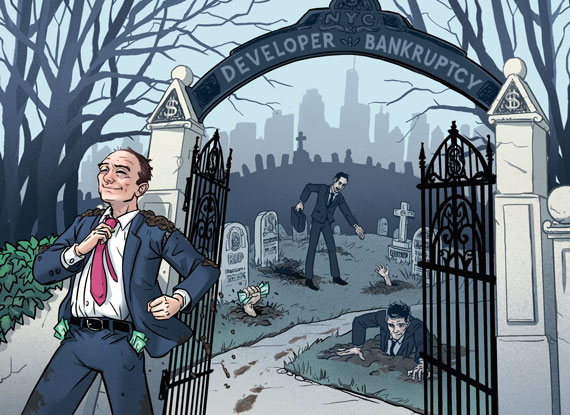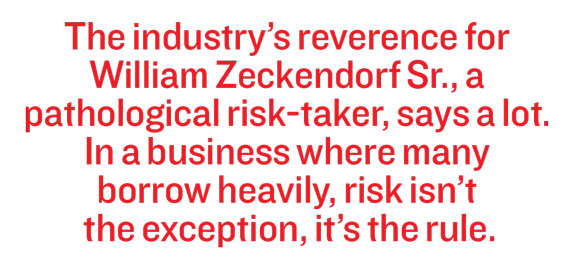Trending
Developers who rise from the dead
Why do some come back from</br> bankruptcy while others get exiled</br> to the lending desert?

Legendary real estate investor William Zeckendorf Sr. owned about as many buildings as he had suits in his wardrobe. And with a fluctuating girth — the famously stout tycoon was known for dropping as much as 40 pounds only to quickly regain it — his closet was lined with a lot of suits.
In other words, his business fortunes yo-yoed the same way his weight did.
One day he would announce a spectacular acquisition — like the Chrysler Building — while the next he would be in a financial scramble. Like some of his high-flying peers, Zeckendorf lived on the edge, often relying on expensive short-term financing to keep his highly leveraged real estate empire afloat.
“I’d rather be alive at 18 percent than dead at the prime rate,” he would often say, according to Tom Schactman’s book “Skyscraper Dreams.”
In 1965, Zeckendorf’s risk-taking finally caught up with him when he declared bankruptcy and lost his entire portfolio to lenders. Before his fall he had projects in the pipeline that were valued at more than half a billion dollars, according to the New York Times.
Nonetheless, his financial demise did little to tarnish his legacy. Today, many real estate leaders consider Zeckendorf, who died in 1976, to be New York’s most visionary developer, in part because he recognized the benefits of high-leverage deals earlier than most.
The industry’s reverence for a pathological risk-taker says a lot about what it takes to succeed. In a business where many rise from modest means by borrowing heavily, risk isn’t the exception. It’s the rule.
“Not one of the sponsors we deal with has not had a [financial] issue at some point in their career,” said Ayush Kapahi, a principal at real estate debt brokerage HKS Capital Partners.
But while some developers never fully recover from financial ruin, others rise again and again. Harry Macklowe and Bruce Eichner, for example, have both defaulted on major loans at least twice, and yet they are currently the talk of the town with their new, sky-high condo developments. Perhaps even more stunning is Donald Trump, whose companies have filed for bankruptcy four times and is now making a run for the White House based on his business and real estate acumen.
As for Zeckendorf, he never recovered. His son William Zeckendorf Jr., who died in 2014, became a successful — and risk-taking — developer in his own right. But he, too, ran into financial troubles and retired in the early 1990s. His sons, Arthur and William, however, have revived the family business, with signature projects such as 15 Central Park West.
Yet the question remains: Why is a default the end of the road for some but not for others?
This month, The Real Deal talked to finance experts and looked at several case studies answering that question. While every default is different, there are some general rules real estate investors should follow if they want to maximize their chances of recovery.
Defaulting 101
The approach a developer takes to defaulting is often just as important as the default itself.
“How an investor group behaves when times go bad is really the important piece,” said Chris Giamo, president of TD Bank’s Metro New York office, which issued $2.75 billion in real estate loans in New York in 2014. “One of the keys is open and upfront communication. Customers don’t like to be surprised by their banks and I don’t think banks like to be surprised by their customers.”
That means approaching the lender to restructure a loan or alert them to financial problems before it’s too late. In addition, if a borrower does default, the best way to preserve a relationship with the lender is to cooperate on a restructuring or a foreclosure, rather than rush to file for bankruptcy. Once a developer files for bankruptcy, it becomes far more difficult for a lender to recoup what he is owed.
“The [bankruptcy] court makes it very difficult for the lender to foreclose,” explained Gabriel Silverstein, head of real estate finance at the Manhattan-based brokerage and investment banking firm Angelic Real Estate. “If the borrower voluntarily and professionally worked with the lender to reasonably foreclose and recover what they could, the lender will be very willing to lend again because he will at least feel comfortable that the borrower won’t be the problem — only the project might.”
Silverstein recalled a borrower who not only filed for bankruptcy in violation of the loan agreement but also sued the lender. “Every lender we talked to said we will never lend them money,” he said.
 Because of experiences like that, lenders sometimes insist on so-called “bad boy” clauses, which automatically make borrowers personally liable for a loan if they commit certain acts, such as filing for bankruptcy.
Because of experiences like that, lenders sometimes insist on so-called “bad boy” clauses, which automatically make borrowers personally liable for a loan if they commit certain acts, such as filing for bankruptcy.
But even declaring bankruptcy doesn’t have to be the end.
Abe Bergman, co-founder and managing partner of mortgage brokerage Eastern Union Funding, explained that most developers operate in joint ventures, and the decision to declare bankruptcy isn’t always unanimous. That’s why lenders look at how individual partners behave in the process.
“A year ago we financed a borrower who had two bankruptcies in the past where he was not a managing member and had tried what he could to avoid bankruptcy,” Bergman said.
The upper hand
Like any industry, having strong relationships with lenders is key to keeping the money flowing. And establishing a track record is an important part of that process.
Recruiting a golf buddy at even one top bank can have a significant domino effect with other lenders. If a borrower works successfully with that lender, it reassures other lenders that the firm is a safe bet.
“If you want to bring a borrower to a new lender and have a reference from another lender, that says a lot about [the borrower’s] character,” Bergman said.
When defaulting, it also helps to owe a lot of money. A bank is far more likely to agree to restructure a multibillion-dollar loan than a single-family mortgage. That’s because borrowers who owe more money have more leverage over the bank.
It explains a popular saying in the industry: “If I owe you a million dollars, you have me by the balls. If I owe you a hundred million dollars, I have you by the balls.”
Zeckendorf reportedly said something to that effect in a conversation with developer Alan Tishman shortly before he went bankrupt. According to a passage in “Skyscraper Dreams,” Tishman and Zeckendorf were at a black-tie gala when they ran into each other in the restroom. Dressed in a tuxedo and standing at a urinal, Zeckendorf turned to Tishman and complained: “How can they say I’m broke? I owe a billion dollars.”
Lenders also give serious consideration to why a developer went bust. If, for example, the developer made poor decisions on pricing, he will likely get more of a cold shoulder from lenders than if the economic conditions just turned on him.
“A default is not simply a function of a developer’s actions, it’s a function of the market,” HKS Capital’s Kapahi said. He explained that lenders are often more forgiving of defaults during market downturns, which are seen as being beyond a developer’s control.
This is a major reason why so many developers who defaulted after the most recent financial crisis are active again, explained Ken Weissenberg, co-chair of real estate at accounting and advisory firm Eisner Amper.
“The 2007 crash had a lot of casualties, but I don’t think anybody holds most of the people who were down and out personally accountable,” he said. “Even the big gambles of that period, with the exception maybe of Stuyvesant Town, those are valued at more than what they were purchased for in 2007.”
In other words: Just because borrowers couldn’t refinance during a credit crunch doesn’t mean they made bad investment decisions.





